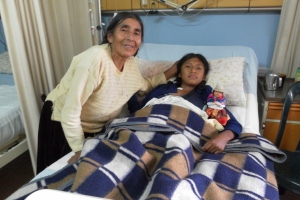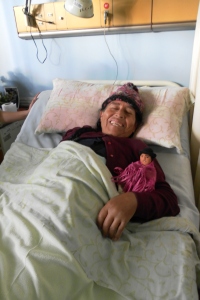Day 7. "To cure" or "to heal"
My sister, an Internist back in Chicago, wrote to me today about having to correct a medical intern who described the physician's goal as being to cure the patient. "No," my sister interrupted, "it is to heal." The distinction was driven home to me today.
I had joined one of the medical teams for rounds this morning, ending in Room 5 with Erika, our 13-year-old recovering from very delicate lung surgery headed by our missioner, Dr. John Gregory. The doctors then rushed off to another full day of surgeries while I reviewed my list of tasks. I decided to set papers aside and head back to Erika's room, where I hunted down a bench to pull up beside her. I felt guilty for such an indulgence, knowing the doctors would be on their feet the next 10 hours, but I reminded myself that this was important, too. Erika rarely cracks a smile, and there is more often a tear streak down her cheek, especially when Grandmother Remigia is not here. So I sat and held her hand. She's especially nervous when the nurses come so I had one take my blood pressure, too. I asked about her sister and her school, but her chin barely lifted. Remigia had mentioned a best friend back home, so I asked about her and what they liked to play. For the first time she had more than a one-word response, telling me how they loved to play dolls. When I saw that it was 10:00 I promised to return later and went outside to find Remigia. Although visiting hours don't start until 1:00, I knew Remigia would be waiting and my lab coat and western features would be enough to sneak her upstairs.

 Later that night I had just a few minutes to dash back to Room 5. I had actually purchased 2 dolls, the second an elaborate Bolivian "Chola" with a pink crocheted shawl and golden ruffled skirt. Trifonia's eyes opened wide and she took it in both hands and planted a kiss smack on its lips before tucking it in the crook of her arm. Her 78-year-old mother and all of her children beamed, exclaiming "your first doll!" I wondered if I had misunderstood so I asked if it was true that she had never had a doll before. They all shook their heads no, implying that it was too much of a luxury.
Later that night I had just a few minutes to dash back to Room 5. I had actually purchased 2 dolls, the second an elaborate Bolivian "Chola" with a pink crocheted shawl and golden ruffled skirt. Trifonia's eyes opened wide and she took it in both hands and planted a kiss smack on its lips before tucking it in the crook of her arm. Her 78-year-old mother and all of her children beamed, exclaiming "your first doll!" I wondered if I had misunderstood so I asked if it was true that she had never had a doll before. They all shook their heads no, implying that it was too much of a luxury.
I still felt terribly guilty that I could enjoy these moments with our patients while the doctors at this late hour had yet to eat or even sit down. Fortunately they also know what I was now understanding on this final day of surgeries: that sometimes this "work" was perhaps as important as their's (albeit much easier) in the ultimate goal to heal our patients, and their families as well .
